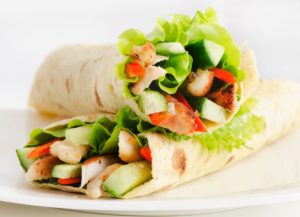Many parents dread the thought of getting back to lunch box preparation in September. However up to 1/3 of our children’s food is eaten in school and plays an important role in forming eating habits, so it is important to try to ensure that lunchboxes are as healthy as possible. For ideas read on, or tune into TV3 Saturday AM on 2nd September to see Glenville Nutrition sharing her top tips.
What’s wrong with a ham sambo?
- Surveys show that the ham sambo on white bread is still by far the most popular option for school lunchboxes. However industrial sliced bread has up to 20 ingredients, most of which belong in a lab rather than a kitchen. It’s lower in fibre than it’s wholegrain counterpart and we know that the majority of Irish children are not eating enough fibre
- Most processed meat is reformed from less desirable cuts of meat held together with a range of gels, gums, additives and preservatives – yuk! The World Health Organisation have warned that eating processed meats such as ham, bacon and salami can increase our risk of colon cancer. Once in a while is not a problem, but if that is your go-to lunchbox option, you could be encouraging food habits that are detrimental to your child’s health in the long term. Swap ham for egg, fish, hummus, peanut butter or leftover meat e.g. roast chicken
- Instead of a sandwich try a slice of quiche, vegetable soup (home-made or a good shop bought version), chilli or other hot meal, wholegrain rice cakes with dip, sushi, falafel…..
What should be included in a lunch box
- At least one portion of vegetables – We should all be eating at least 5 portions of veg per day, so squeeze at least one into the lunchbox to boost fibre and nutrient intake
- One portion of fruit – fruit are good sources of vitamins including vitamin C. Make sure to give a variety. Try grapes, berries, melon / pineapple chunks, wedges of kiwi / orange, apples, pears….
- Healthy protein – including eggs, fish (try tinned wild salmon), cheese, yoghurt, nuts and nut butters, seeds, roast chicken, falafel. Protein is important in a child’s diet to support growth and development
- Wholegrain – for fibre and to provide sustained energy. Try wholegrain bread, wholegrain wraps and pittas, wholegrain crackers, oatcakes, rice cakes…
What to drink?
- Always give water to drink. The average primary school child needs to drink about 1.5L water daily.
- Kids are greater risk of dehydration than adults due to their lower body weight and smaller reserve of body fluids. They can also fail to recognise the early stages of thirst. Research suggests that just a 1% to 2% body water loss can lead to significant reductions in concentration and mental performance
- Avoid sugary drinks including fruit juices, cordials, flavoured milks and yoghurt drinks. Give water instead and try flavouring it with fresh fruit
- If your child is sporty, they will need more water. Make sure to include additional water in their sports bag or remind them to refill their water bottle
- If the weather is warm, fill water bottles the night before and freeze. This will help to keep the lunchbox cooler and avoid food ‘going off’
Get some of our favourite recipes here, including wholegrain pitta chips, pesto dip, cheddar and courgette muffins, banana oat bites…
Dealing with picky eaters
- Presentation is important. Some children like to eat different foods separately. Get a lunchbox with different compartments and cut food into bite-sized pieces
- Make it easy for your kids e.g. peel oranges or cut them into quarters, give chopped instead of whole fruit
- Get your child involved in preparing the lunchbox and choosing what goes into it – guided by you of course!
- Sneak the stuff they don’t like (usually veggies) into quiches / muffins / sandwiches / pasta sauce….
- If your child doesn’t like sandwiches, buy a food flask so that they can take a portion of dinner to school
- Make changes gradually and agree them with your kids. For example, if switching from white to brown bread, start by using one slice of each in a sandwich
Shopping staples
While in an ideal world, we may all be sweating over a hot stove, in the real world most of us want short cuts. In the supermarket steer clear of products aimed specifically at kids, like yoghurt tubes and cereal bars. Most of these are high in sugar and expensive. Some better buys include:
- Pack with some veg sticks, wholegrain pitta strips and hummus
- Sliced cheese. This is usually a better option than cheese strings or other heavily processed cheese
- Fresh pesto. Spread on a wrap or mix with full fat yoghurt to make a healthy dip
- Chose a variety with a short ingredient list and avoid any that contain sweeteners
- Fresh, vegetable-based soups. Just Food, Happy Pear and Fusion Kitchen are good brands to try
- Mini packs of nuts and seeds are a great addition to lunchboxes and full of healthy fats
- Sugar snap peas – no chopping required, just wash and go!
- Wholegrain crackers – oat cakes, rice cakes, Ryvita…. Many are packed in small packs of 3 or 4, ideal for lunch boxes
Top tips
- Always include a portion of vegetables
- Try to plan ahead e.g. keep some roast chicken from dinner to make sandwiches
- Vary what you include
- Get your kids involved and ask what they like. And what good ideas they have from friends!
- Have a healthy option e.g. soup ready for when they get home
A lunchbox plan for a week
| Monday
|
Wholegrain chicken and pepper sandwich, apple, carrot sticks |
| Tuesday | Wholegrain pitta with tinned salmon and sweetcorn, natural yoghurt with berries, pepper sticks |
| Wednesday | Tomato and lentil soup, cheddar and grape sticks, oat cakes, cucumber sticks |
| Thursday
|
Falafel, hummus, pitta crisps, sugar snap peas, 2 plums |
| Friday | Wholegrain pasta with pesto and peas, watermelon pieces, nuts / seeds, celery sticks |
Other tips:
- Where time allows, try making savoury muffins, fruit and nut-based treats or oat slices
- To make a healthier mayo, mix 2 tbsp. good quality mayo, 2 tbsp. natural yoghurt, 1 tsp mustard


